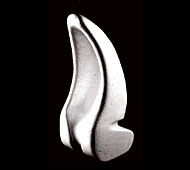Cultural and religious beliefs preclude sculpting human or animal forms in Saudi Arabia. For sculptors working in the Kingdom, it’s a creative challenge that requires imagination and perseverance to find expression through their art — the same qualities Saudi youngsters will need to shape a bright future for the generations to come.
Sculptor Ali Al-Tokhais constantly searches for new ideas to inspire his work. The Al-Dawadmi native finds the Arabic alphabet a source for abstract expression. You will rarely notice that it refers to a letter,” Al-Tokhais said. Working with stone is difficult, and the gear he wears not only protects him, but it allows him to detach from the real world.
“While sculpting I use a mask, hand gloves and earplugs,” he said, noting that it allows him to place an extremely sharp focus on his work.
Al-Tokhais is considered by many Saudi and foreign artists to be among the best sculptors in the Kingdom. His forte is rock, and he concentrates on the one medium so that he gains absolute proficiency, understanding all the nuances of coaxing form out of stone.
His work has such a unique sophistication it has garnered awards across the Middle East and Europe. So distinctive is the style that other sculptors gaining inspiration from his work are called members of the Tokhaisian School.
The birthplace of Al-Tokhais also is the hub of sculpture in Saudi Arabia. Sculptor Abdullah Al-Abdullatif, who died in 1411 AD, introduced the art form to Al-Dawadmi. Over the centuries, the traditions have been preserved there, and today it is home to the only institution of higher education teaching the art form in the Kingdom. Al-Tokhais is one of several sculptors who teach there today, showing students how to manipulate a variety of materials, including wood, marble, iron, sand and occasionally crystal.
A Saudi sculptor gets training much as a journeyman, starting out as an art student at a college or a university, then traveling to Al-Dawadmi on the western side of Riyadh to learn the basics. From there, sculptors continue to search for more exhibitions, seminars, festivals and masters to mentor them.
“It is the place for creative artists to appear, only nature and a simple life,” Al-Tokhais said of Al-Dawadmi. He says he takes his students on field trips to get acquainted with nature, to discover new materials and to gain inspiration from Saudi Arabia’s incredible topography.
Saudi sculptors believe sculpting is a field where children of all ages and even the older generation could excel in if they could find experienced people to teach them.
Almost all the artists interviewed for this story agreed that if art form was Introduced to more cities as it is in Al-Dawadmi — much like painting and photography in Jeddah or Riyadh — they would be delighted to share their skills and to anyone who is interested.
Two sculptors, Al-Tokhais and Dammam sculptor Essam Jameel have taken action in hopes of shaping the Kingdom so that their youngsters can shape materials to find creative expression. “I’m doing my best to give my child the softest materials to use as a as a beginning,” Jameel said.
He expressed his frustration with being unable to find any other sources for sculpting in the Eastern Province city. “When I tried to find him a place that offers such courses in Dammam, I failed,” he said. “I wish an appropriate art center with excellent teachers was available to educate our children and the older generation in this type of art.”
Undaunted, Jameel said the Gulf Coast could host different activities to encourage sculpting as a Saudi pastime. Perhaps even castles made of sand could serve a useful purpose.
“Contests for sand sculptures would be an interesting activity that could attract many residents and tourists to see,” Jameel said. “Creative children might be discovered through such activities.”


